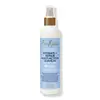What's inside
What's inside
 Key Ingredients
Key Ingredients

 Benefits
Benefits

 Concerns
Concerns

 Ingredients Side-by-side
Ingredients Side-by-side

Water
Skin ConditioningCetearyl Alcohol
EmollientBehentrimonium Chloride
PreservativePPG-3 Benzyl Ether Ethylhexanoate
EmollientGlycerin
HumectantSalvia Hispanica Seed Extract
EmollientTrehalose
HumectantXylitol
HumectantCaprylyl/Capryl Glucoside
CleansingEthyl Linoleate
EmollientEthyl Oleate
EmollientSorbitan Oleate
EmulsifyingPolyquaternium-37
Sodium Phosphate
BufferingDistearyldimonium Chloride
Quaternium-80
Persea Gratissima Oil
Skin ConditioningSclerocarya Birrea Seed Oil
HumectantMauritia Flexuosa Fruit Oil
Skin ConditioningLactobacillus/Tomato Fruit Ferment Extract
Skin ConditioningOryza Sativa Extract
AbsorbentKeratin Amino Acids
Skin ConditioningAcyl Coenzyme A Desaturase
Skin ConditioningTocopherol
AntioxidantParfum
MaskingPhenoxyethanol
PreservativeEthylhexylglycerin
Skin ConditioningCitric Acid
BufferingWater, Cetearyl Alcohol, Behentrimonium Chloride, PPG-3 Benzyl Ether Ethylhexanoate, Glycerin, Salvia Hispanica Seed Extract, Trehalose, Xylitol, Caprylyl/Capryl Glucoside, Ethyl Linoleate, Ethyl Oleate, Sorbitan Oleate, Polyquaternium-37, Sodium Phosphate, Distearyldimonium Chloride, Quaternium-80, Persea Gratissima Oil, Sclerocarya Birrea Seed Oil, Mauritia Flexuosa Fruit Oil, Lactobacillus/Tomato Fruit Ferment Extract, Oryza Sativa Extract, Keratin Amino Acids, Acyl Coenzyme A Desaturase, Tocopherol, Parfum, Phenoxyethanol, Ethylhexylglycerin, Citric Acid
Water
Skin ConditioningCetrimonium Chloride
AntimicrobialCaprylic/Capric Triglyceride
MaskingGlycerin
HumectantButyrospermum Parkii Butter
Skin ConditioningHoney
HumectantYogurt Powder
Yogurt Extract
Skin ConditioningInulin
Skin ConditioningAdansonia Digitata Seed Oil
EmollientTrichilia Emetica Seed Oil PEG-8 Esters
EmollientHydrolyzed Wheat Protein Pg-Propyl Silanetriol
Skin ConditioningBisabolol
MaskingTocopherol
AntioxidantStearyl Alcohol
EmollientCetyl Alcohol
EmollientTriethyl Citrate
MaskingCaprylyl Glycol
EmollientBenzoic Acid
MaskingParfum
MaskingWater, Cetrimonium Chloride, Caprylic/Capric Triglyceride, Glycerin, Butyrospermum Parkii Butter, Honey, Yogurt Powder, Yogurt Extract, Inulin, Adansonia Digitata Seed Oil, Trichilia Emetica Seed Oil PEG-8 Esters, Hydrolyzed Wheat Protein Pg-Propyl Silanetriol, Bisabolol, Tocopherol, Stearyl Alcohol, Cetyl Alcohol, Triethyl Citrate, Caprylyl Glycol, Benzoic Acid, Parfum
 Reviews
Reviews

Ingredients Explained
These ingredients are found in both products.
Ingredients higher up in an ingredient list are typically present in a larger amount.
Glycerin is already naturally found in your skin. It helps moisturize and protect your skin.
A study from 2016 found glycerin to be more effective as a humectant than AHAs and hyaluronic acid.
As a humectant, it helps the skin stay hydrated by pulling moisture to your skin. The low molecular weight of glycerin allows it to pull moisture into the deeper layers of your skin.
Hydrated skin improves your skin barrier; Your skin barrier helps protect against irritants and bacteria.
Glycerin has also been found to have antimicrobial and antiviral properties. Due to these properties, glycerin is often used in wound and burn treatments.
In cosmetics, glycerin is usually derived from plants such as soybean or palm. However, it can also be sourced from animals, such as tallow or animal fat.
This ingredient is organic, colorless, odorless, and non-toxic.
Glycerin is the name for this ingredient in American English. British English uses Glycerol/Glycerine.
Learn more about GlycerinParfum is a catch-all term for an ingredient or more that is used to give a scent to products.
Also called "fragrance", this ingredient can be a blend of hundreds of chemicals or plant oils. This means every product with "fragrance" or "parfum" in the ingredients list is a different mixture.
For instance, Habanolide is a proprietary trade name for a specific aroma chemical. When used as a fragrance ingredient in cosmetics, most aroma chemicals fall under the broad labeling category of “FRAGRANCE” or “PARFUM” according to EU and US regulations.
The term 'parfum' or 'fragrance' is not regulated in many countries. In many cases, it is up to the brand to define this term.
For instance, many brands choose to label themselves as "fragrance-free" because they are not using synthetic fragrances. However, their products may still contain ingredients such as essential oils that are considered a fragrance by INCI standards.
One example is Calendula flower extract. Calendula is an essential oil that still imparts a scent or 'fragrance'.
Depending on the blend, the ingredients in the mixture can cause allergies and sensitivities on the skin. Some ingredients that are known EU allergens include linalool and citronellol.
Parfum can also be used to mask or cover an unpleasant scent.
The bottom line is: not all fragrances/parfum/ingredients are created equally. If you are worried about fragrances, we recommend taking a closer look at an ingredient. And of course, we always recommend speaking with a professional.
Learn more about ParfumTocopherol (also known as Vitamin E) is a common antioxidant used to help protect the skin from free-radicals and strengthen the skin barrier. It's also fat soluble - this means our skin is great at absorbing it.
Vitamin E also helps keep your natural skin lipids healthy. Your lipid skin barrier naturally consists of lipids, ceramides, and fatty acids. Vitamin E offers extra protection for your skin’s lipid barrier, keeping your skin healthy and nourished.
Another benefit is a bit of UV protection. Vitamin E helps reduce the damage caused by UVB rays. (It should not replace your sunscreen). Combining it with Vitamin C can decrease sunburned cells and hyperpigmentation after UV exposure.
You might have noticed Vitamin E + C often paired together. This is because it is great at stabilizing Vitamin C. Using the two together helps increase the effectiveness of both ingredients.
There are often claims that Vitamin E can reduce/prevent scarring, but these claims haven't been confirmed by scientific research.
Learn more about TocopherolWater. It's the most common cosmetic ingredient of all. You'll usually see it at the top of ingredient lists, meaning that it makes up the largest part of the product.
So why is it so popular? Water most often acts as a solvent - this means that it helps dissolve other ingredients into the formulation.
You'll also recognize water as that liquid we all need to stay alive. If you see this, drink a glass of water. Stay hydrated!
Learn more about Water